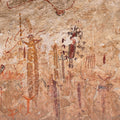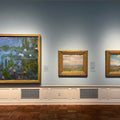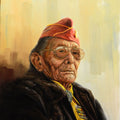Jody Guralnick's lichen paintings bring overlooked worlds into view
By Chadd Scott on
Western art specializes in the monumental: mountains, canyons, mesas.
Jody Guralnick specializes in the microscopic: lichen, mold, mushrooms.
Guralnick’s (b. 1953) interest in the small began as a child during summers on Cape Cod and Martha’s Vineyard. She loved nosing around the tidal pools where a careful observer can find a complete universe within a few square feet.
From her home in Boston, Guralnick ventured to London for art school and then additional training at Pratt Institute in New York. She kept looking down, continually fascinated by what most never saw.

Jody Guralnick, ‘Inflorescence,’ 2023; oil on wood panels. 60 x 144 inches. Courtesy of the artist and Nancy Hoffman Gallery.
“You know that expression ‘you can't see the forest for the trees,’ I don't even get the point of that expression; I don't want to see the forest, I want to see the individual trees,” Guralnick said. “I'm very interested in up close and tiny, it's the way my brain works and my aesthetics work. I've always been someone who sees that the objects in a space help define the bigger space.”
Trees and forests would come, but later.
The detritus of cities first inspired Guralnick’s artmaking. Discarded packaging, used up subway tickets, orphaned buttons, and all the stuff that collects in corners. Her medium was collage.
Guralnick’s early professional years coincided with a uniquely creative time and place: New York in the late 70s and early 80s. Her first show included Keith Haring among others. Concerts at CBGB’s. Debbie Harry at Mud Club.
She even worked for Andy Warhol. For about two days.
“Warhol said he liked the way I answered the phone,” Guralnick remembers.
She never had any idea what she was supposed to be doing though, wandering around the Chelsea Hotel taking photos to who knows who for who knows what reason.
After nine years in New York, a job opportunity for her architect husband in Aspen, CO would have Guralnick begrudgingly leaving the city in the mid-80s, still a long way from those trees and the artwork she makes now.

Jody Guralnick ‘Virgin’s Bower, 2022; oil and acrylic on panel, 16 x 12 inches. Courtesy of the artist and Nancy Hoffman Gallery.
From Johnny Rotten to John Denver
Guralnick knew trading the scene of New York for the slopes of Aspen was best for her family.
“I got used to it eventually,” she said. “I felt like a very urban person, and it took me a number of years of being in Aspen to suddenly realize – no wait – this is as interesting as the streets of New York, it's just a different kind of thing.”
Once again, it was from looking down where she found familiarity. Comfort and wonder returning via the small.
“I was very into the odds and ends of urban life, but at some point, I realized this has odds and ends too, only they’re mushrooms and pine cones, I started looking at it the same way,” Guralnick recalls. “I realized the woods were like one huge tidal pool. You could look at the big trees and you could look at the mountains, or you could just get up close and really see what it was all made of, all the little building blocks that make up the big picture. That's how I looked at cities, too.”
Tidal pools. City streets. An alpine rock.
The same.
Still in Aspen today, Guralnick paints lichen while also working with the Forest Conservancy, teaching at Anderson Ranch, and giving educational tours in the Rockies. She’s a master naturalist following decades of close observation.
All the time, looking down.
“The big picture has never interested me and I realized if you walk around in the woods with a magnifying loop you get to see worlds within worlds within worlds,” Guralnick said. “It's like that old tidal pool, you're getting to see lives lived out on this tiny scale, but that are actually the tip of the iceberg of enormous lives, especially once you start doing things like mushrooms because those are enormous, enormous organisms and we just are seeing the tiniest bit of them when we see their little fruiting body.”

Jody Guralnick, ‘Did You See,’ 2023; oil and acrylic on two panels. 48 x 72 inches. Courtesy of the artist and Nancy Hoffman Gallery.
Painting the Microscopic
Guralnick’s lichen and fungi paintings are not realistic. Her aim is not botanical illustration.
“When I go in the studio, I just say to myself, ‘Okay, here's how you felt when you saw those things. Here's what those lives were saying to you,’” Guralnick explains. “I’m interested in nature as muse.”
She paints from memory and feeling, not photographs. She spends countless hours in nature, much of it at 10,000-plus-feet elevation under what she terms, “an impossibly blue Colorado sky.”
What she sees there – looking down – is what she paints.
“I have so much information in my brain when I start working,” Guralnick said. “(I) think about how I got to sort of hear their voices. I feel like when you look really closely, you get to be in on the secret. There are all these voices in the wild whispering to you If you just are paying enough attention.”
Her artworks begin as abstractions in oil paint. That’s the background, the underpainting. She lets these dry completely before moving on to a topical application of acrylic paint. Acrylic is not supposed to be applied on top of oil which is why the first paint layer must dry totally.
Gurlanick then applies the acrylic using a tiny bottle with a pinhole opening reminiscent of cake decorating.
“Then I just draw, I just kind of go,” she said. “I don't plan it ahead; I think to myself, is this growing like this, is it reaching out, and then there's something coming in underneath it and then maybe this is going over here, and I try to channel it, what I've seen without being too literal, the feeling of it.”
The top acrylic layer gives her paintings physical relief like beadwork or leather tooling.
Or a starfish in a tidal pool. Or a discarded gum wrapper on a sidewalk. Or a pinecone on the forest floor.
Jody Guralnick’s paintings made in Aspen between 2022 and the present return her to New York with an exhibition at Nancy Hoffman Gallery (520 W. 27th Street in Chelsea) through March 16, 2024.



